
The common swift is a medium-sized bird, superficially similar to the barn swallow or house martin but somewhat larger, though not stemming from those passerine species, being in the order Apodiformes. The resemblances between the groups are due to convergent evolution, reflecting similar contextual development. The swifts' nearest relatives are the New World hummingbirds and the Southeast Asian treeswifts.

The alpine swift formerly Apus melba, is a species of swift found in Africa, southern Europe and Asia. They breed in mountains from southern Europe to the Himalaya. Like common swifts, they are migratory; the southern European population winters further south in southern Africa. They have very short legs which are used for clinging to vertical surfaces. Like most swifts, they never settle voluntarily on the ground, spending most of their lives in the air living on the insects they catch in their beaks.

The little swift, is a small species of swift found in Africa and southwestern Asia, and are vagrants and local breeders in southern Europe. They are found both in urban areas and at rocky cliffs where they build nests in a way typical of all members of the order Apodiformes. The genus name Apus is Latin for a swift, thought by the ancients to be a type of swallow without feet. The Latin specific affinis means similar to or related to, but in this case the species that the little swift supposedly resembles is not clear from the description. A population formerly considered to be an eastern subspecies of little swift is now separated as a distinct species, the house swift.
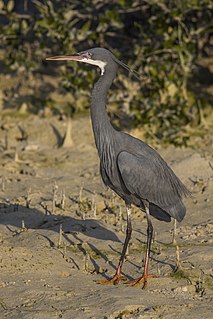
The western reef heron, also called the western reef egret, is a medium-sized heron found in southern Europe, Africa and parts of Asia. It has a mainly coastal distribution and occurs in several plumage forms: a slaty-grey plumage in which it can only be confused with the rather uncommon dark morph of the Little egret ; a white form which can look very similar to the little egret although the bill tends to be paler and larger and the black form with white throat E. g. gularis of West Africa. There are also differences in size, structure and foraging behaviour. There have been suggestions that the species hybridizes with the Little Egret, and based on this, some authors treat schistacea and gularis as subspecies of Egretta garzetta. Works that consider the Western Reef Heron as a valid species include the nominate gularis and schistacea as subspecies.

The bronze mannikin or bronze munia is a small passerine bird of the Afrotropics. This very social estrildid finch is an uncommon to locally abundant bird in much of Africa south of the Sahara Desert, where it is resident, nomadic or irruptive in mesic savanna or forest margin habitats. It has an estimated global extent of occurrence of 8,100,000 km2. It is the smallest and most widespread of four munia species on the African mainland, the other being black-and-white, red-backed and magpie mannikin. It co-occurs with the Madagascar mannikin on the Comoro Islands, and was introduced to Puerto Rico. Especially in the West Africa, it is considered a pest in grain and rice fields. It is locally trapped for the pet bird trade.

The Seychelles bulbul is a member of the bulbul family of passerine birds. It is a common endemic species of the Seychelles, breeding on Mahé, Praslin, La Digue and Silhouette as well as some smaller islands.

Humblot's flycatcher or the Grand Comoro flycatcher, is a small passerine bird belonging to the Old World flycatcher family. It is the only member of its genus. Humblot's flycatcher is endemic to the island of Grand Comoro in the Comoros where it inhabits forest on the slopes of Mount Karthala. The scientific name commemorates the French naturalist Léon Humblot.
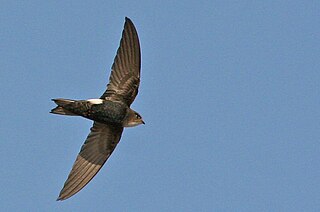
The Horus swift is a small bird in the swift family. It breeds in sub-Saharan Africa. It has an extensive continuous distribution from eastern and southern South Africa north to southern Zambia and central Mozambique, and has recently colonised the De Hoop Nature Reserve area of the Western Cape.
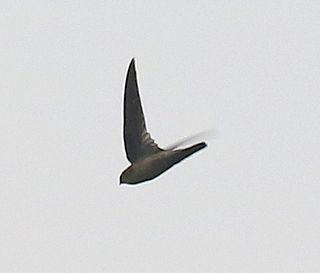
The Himalayan swiftlet is a small swift. It is a common colonial breeder in the Himalayas and Southeast Asia. Some populations are migratory.

The Malagasy black swift or Madagascar swift, is a species of swift in the family Apodidae. It is endemic to Madagascar and the Comoro Islands.

The Malagasy pond heron is a species of heron of the family Ardeidae. They are primarily seen in the outer islands of the Seychelles, Madagascar, and on the east coast of Africa including Kenya, Tanzania, and Uganda. Being native to Madagascar, this species is often referred to as the Madagascar pond heron or Madagascar squacco heron. The population of this heron is estimated at 2,000–6,000 individuals, with only 1,300–4,000 being mature enough to mate.

The Malagasy coucal or Madagascar coucal is a species of cuckoo in the family Cuculidae. It is found in Madagascar and in the Seychelles, where it occurs on Aldabra and was formerly present on Assumption Island and Cosmoledo. Its natural habitats are dense vegetation in subtropical or tropical moist lowland forests, mangrove forests, rough grassland, marshes and reedbeds.
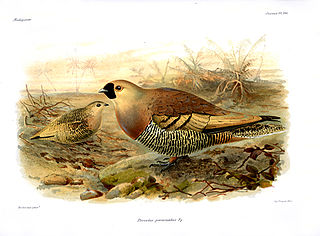
The Madagascar sandgrouse is a species of bird in the family Pteroclidae. It is endemic to Madagascar and is a ground-dwelling short-legged plump bird. The head of the male is brown with a black area surrounding the beak. He has a pinkish-buff coloured breast, a light brown mottled back, brown wings and paler underparts barred with dark brown. The female has a generally duller appearance being cryptically coloured brown with dark specks and bars.

The blue vanga is a bird species in the family Vangidae. It is in the monotypic genus Cyanolanius. It is found in Comoros, Madagascar, and Mayotte, where its natural habitats are subtropical or tropical dry forest and subtropical or tropical moist lowland forest.

The Mascarene martin or Mascarene swallow is a passerine bird in the swallow family that breeds in Madagascar and in the Mascarene Islands. The nominate subspecies occurs on Mauritius and Réunion and has never been found away from the Mascarene Islands, but the smaller Madagascan subspecies, P. b. madagascariensis, is migratory and has been recorded wintering in East Africa or wandering to other Indian Ocean islands.
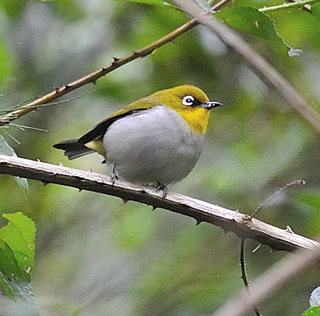
The Malagasy white-eye is a species of bird in the white-eye family, Zosteropidae. Found in the Comoros, Madagascar, Mayotte, and Seychelles, its natural habitats are subtropical or tropical dry forests, subtropical or tropical moist lowland forests, subtropical or tropical mangrove forests, and subtropical or tropical moist montane forests.

The Apodinae are a subfamily of swifts and contain the following species:




















